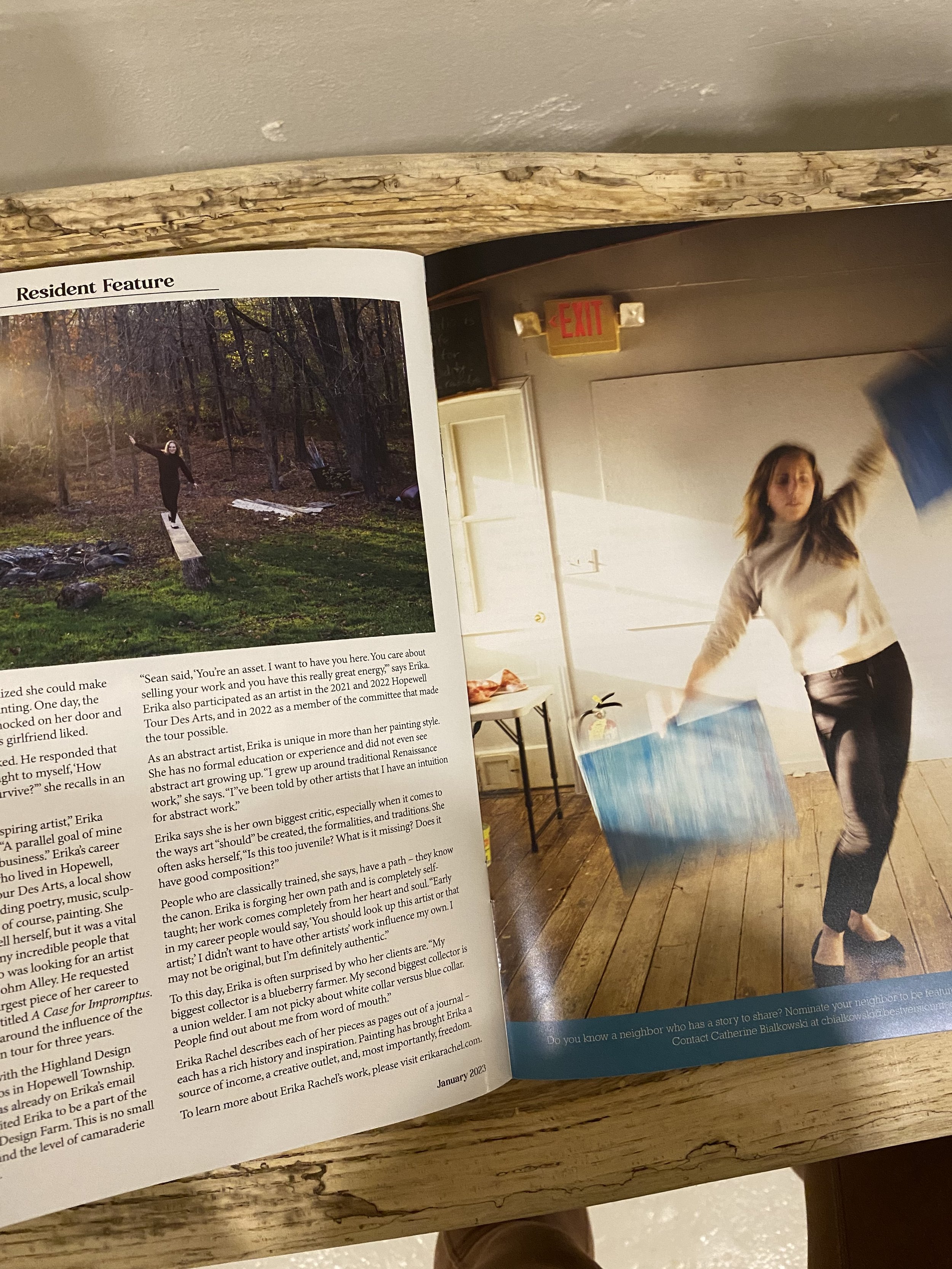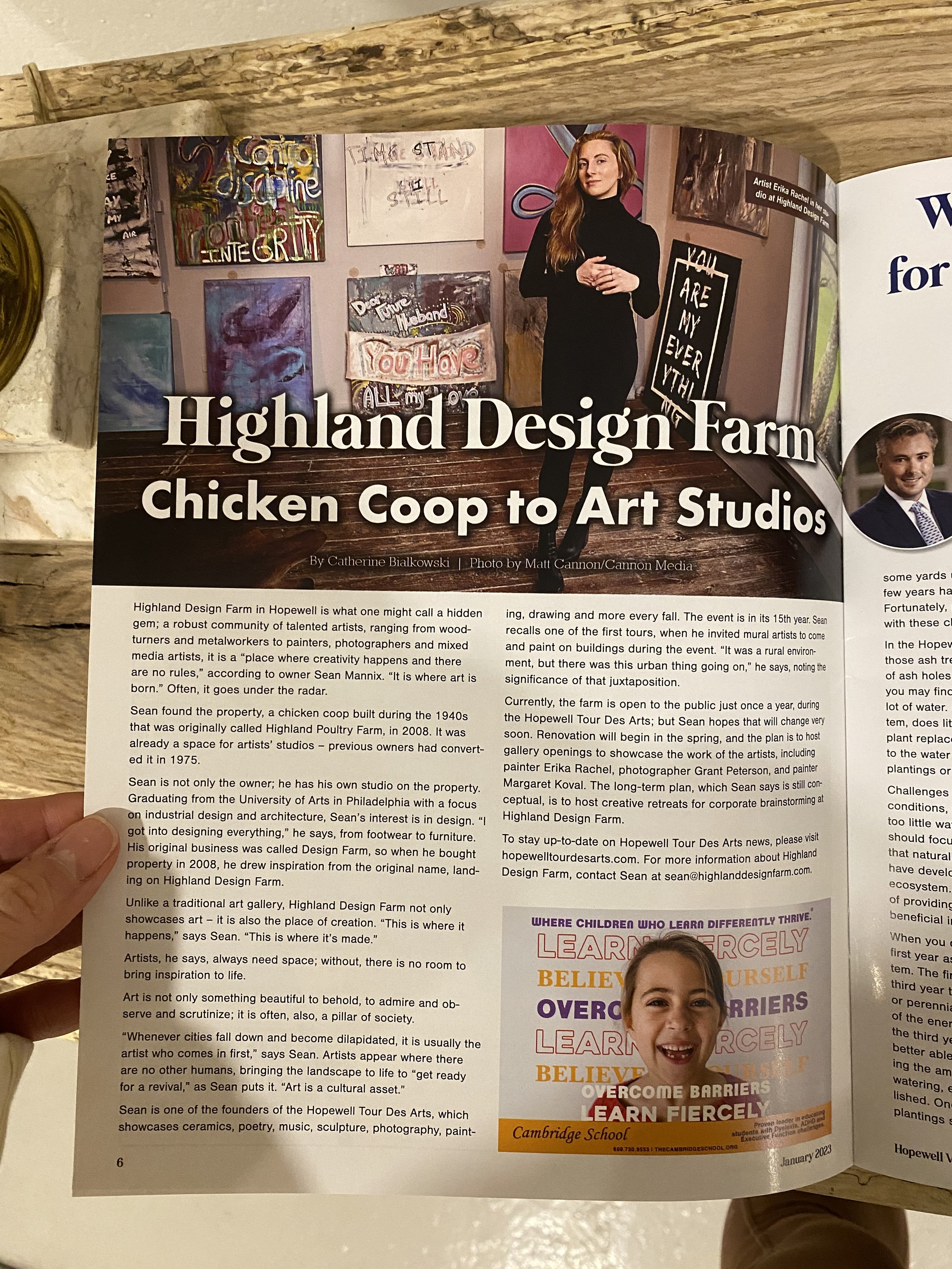Press: Hopewell Valley Neighbors January 2023 Cover Story, Erika Rachel, Freedom Through Art
By Catherine Bialkowski Photos by Benoit Cortet
For Erika Rachel, art has been a constant, a comfort, a source of joy and meaning. Ever the entrepreneur, even as a teenager, Erika expressed her creativity and ambition through various business ventures from photography, to web design, to an after-school enrichment program for children. It was not until 2013, though, that she became a painter.
Erika was born in Staten Island and later moved to Plainfield, then Milford. As a teenager, she did not feel traditional school was for her, and she dropped out of high school."I always had a desire to have freedom, she says. "Freedom for me was number one - freedom of time, freedom of schedule." As an employee at various jobs throughout her youth, she felt constricted by the expectations of her bosses; expectations that did not align with the things she herself valued. When she married, she once again felt confined by the "woulds" and "shoulds" of marriage and the stipulations of her then-husband. During this time she had one canvas that she worked on from time to time, abandoning any rules of art, and allowing herself to fully express what she was feeling.
Then one week in late 2012, Erika's life was drastically altered when two fundamental parts of it ceased, suddenly, to exist. An officer came knocking on her door to let her know her father had passed away. Days before, she and her husband had settled on divorce.
What ensued was a period of darkness for Erika, though she endured. In early 2013, Erika moved into her late father's house. It felt strange to be living on her own, in a place she had lived as a teenager. "For the first time, I had no male figure in my life dictating my every move," says Erika."I had freedom to make my own decisions."
Painting was a source of consolation for Erika during this time. It was also a form of expression, not dissimilar to pouring emotion into a diary through written word. It was during this time that Erika fully immersed herself in her art, to cope with the stresses and anxieties of reality; she did not know how she was going to make money, pay her bills, or navigate this new independent life back in her rural hometown. "I started creating - pouring myself out onto canvas after canvas. When I finally caught a break from the transition that that period of my life was, I wept, just released all the pain that had been pent up trying to make it one more day, make it through the next hour. 'I can survive. I can be fine. What doesn't kill you makes you stronger."
Erika remembers the precise moment she realized she could make a living doing the thing she loved: abstract painting. One day, the boyfriend of her close friend and neighbor knocked on her door and inquired if Erika still had the painting that his girlfriend liked.
"Yeah, you want to buy it?" Erika jokingly asked. He responded that he did. "I took that check from him and thought to myself, 'How many of these do I have to sell a month to survive?’” she recalls in an "aha moment."
"It wasn't like - I'm going to be this great, inspiring artist, Erika says. At that moment, it was about survival. "A parallel goal of mine was always to be a successful female in my business." Erika's career advanced when a friend of hers, an artist who lived in Hopewell, invited her to volunteer at the Hopewell Tour Des Arts, a local show that exhibits the work of local artists, including poetry, music, sculp-ture, ceramics, drawing, photography and, of course, painting. She was neither in the show nor from Hopewell herself, but it was a vital opportunity for networking. "I met so many incredible people that weekend, she says. She met someone who was looking for an artist to be in an outdoor show in Princeton, Dohm Alley. He requested a piece from Erika, and she created the largest piece of her career to that point, a four- by eight-foot painting titled A Case for Impromptus The piece was part of a project centered around the influence of the poets of the Romantic period and was on tour for three years.
Over time, Erika also became familiar with the Highland Design Farm, a location for artists to rent studios in Hopewell Township.
Lots of arms out in this one.
Owner Sean Mannix, coincidentally, was already on Erika's email list on her website. Eventually, Sean invited Erika to be a part of the community of artists that is Highland Design Farm. This is no small feat; Sean carefully curates the artists, and the level of camaraderie and talent at the studios is unmatched.
"Sean said, You're an asset. I want to have you here. You care about selling your work and you have this really great energy," says Erika.
Erika also participated as an artist in the 2021 and 2022 Hopewell
Tour Des Arts, and in 2022 as a member of the committee that made the tour possible.
As an abstract artist, Erika is unique in more than her painting style.
She has no formal education or experience and did not even see abstract art growing up. "I grew up around traditional Renaissance work, she says. "I*ve been told by other artists that I have an intuition for abstract work."
Erika says she is her own biggest critic, especially when it comes to the ways art "should" be created, the formalities, and traditions. She often asks herself, "Is this too juvenile? What is it missing? Does it have good composition?"
People who are classically trained, she says, have a path - they know the canon. Erika is forging her own path and is completely self-taught; her work comes completely from her heart and soul. "Early in my career people would say, 'You should look up this artist or that artist,' I didn't want to have other artists' work influence my own. I may not be original, but I'm definitely authentic."
To this day, Erika is often surprised by who her clients are. "My biggest collector is a blueberry farmer. My second biggest collector is a union welder. I am not picky about white collar versus blue collar. People find out about me from word of mouth."
Erika Rachel describes each of her pieces as pages out of a journal - each has a rich history and inspiration. Painting has brought Erika a source of income, a creative outlet, and, most importantly, freedom.
Same Issue, Different Article
Highland Design Farm: Chicken Coop to Art Studios
By Catherine Bialkowski Photos by Matt Cannon/Cannon Media
Highland Design Farm in Hopewell is what one might call a hidden gem; a robust community of talented artists, ranging from wood-turners and metalworkers to painters, photographers and mixed media artists, it is a "place where creativity happens and there are no rules," according to owner Sean Mannix. "It is where art is born." Often, it goes under the radar.
Sean found the property, a chicken coop built during the 1940s that was originally called Highland Poultry Farm, in 2008. It was already a space for artists' studios - previous owners had converted it in 1975
Sean is not only the owner; he has his own studio on the property.
Graduating from the University of Arts in Philadelphia with a focus on industrial design and architecture, Sean's interest is in design. "I got into designing everything," he says, from footwear to furniture.
His original business was called Design Farm, so when he bought property in 2008, he drew inspiration from the original name, landing on Highland Design Farm.
Unlike a traditional art gallery, Highland Design Farm not only showcases art - it is also the place of creation. "This is where it happens," says Sean. "This is where it's made."
Artists, he says, always need space; without, there is no room to bring inspiration to life
Art is not only something beautiful to behold, to admire and observe and scrutinize; it is often, also, a pillar of society.
"Whenever cities fall down and become dilapidated, it is usually the artist who comes in first." says Sean. Artists appear where there are no other humans, bringing the landscape to life to "get ready for a revival," as Sean puts it. "Art is a cultural asset."
Sean is one of the founders of the Hopewell Tour Des Arts, which showcases ceramics, poetry, music, sculpture, photography, paint-
ing, drawing and more every fall. The event is in its 15th year. Sex recalls one of the first tours, when he invited mural artists to come and paint on buildings during the event. "It was a rural environ. ment, but there was this urban thing going on, he says, noting be significance of that juxtaposition.
Currently, the farm is open to the public just once a year, during the Hopewell Tour Des Arts; but Sean hopes that will change very soon. Renovation will begin in the spring, and the plan is to hos gallery openings to showcase the work of the artists, including painter Erika Rachel, photographer Grant Peterson, and painter Margaret Koval. The long-term plan, which Sean says is still con-ceptual, is to host creative retreats for corporate brainstorming al
Highland Design Farm
To stay up-to-date on Hopewell Tour Des Arts news, please visit hopewelltourdesarts.com. For more information about Highland Design Farm, contact Sean at sean@highlanddesignfarm.com.



